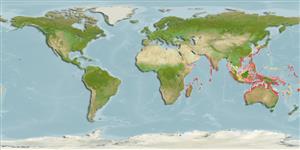>
Eupercaria/misc (Various families in series Eupercaria) >
Lethrinidae (Emperors or scavengers) > Lethrininae
Etymology: Lethrinus: Greek, lethrinia, a fish pertaining to genus Pagellus.
More on author: Valenciennes.
Environment: milieu / climate zone / تغييرات عمق / distribution range
بوم شناسي
دريايي; لب شور وابسته به آب سنگ; غير مهاجر; تغييرات عمق 5 - 25 m (Ref. 1602). Tropical; 35°N - 30°S
Indo-West Pacific: Indonesia (including eastern Indian Ocean side), northwestern Australia, Philippines, southern Japan, Papua New Guinea and the Caroline Islands. This species has long been recognized as Lethrinus nematacanthus and the name Lethrinus genivittatus misassociated with many other species.
Size / Weight / سن
بلوغ: Lm ? range ? - ? cm
Max length : 25.0 cm TL جنس نر / بدون خواص جنسي; (Ref. 2295); common length : 15.0 cm TL جنس نر / بدون خواص جنسي; (Ref. 2295); بيشينه سن گزارش شده: 7 سال ها (Ref. 2290)
خارهاي باله پشتي (کل) : 10; شعاع نرم باله پشتي (کل) : 9; خارهاي باله مخرجي: 3; شعاع نرم باله مخرجي: 8. The only Lethrinus with its 2nd dorsal spine the longest. The inner surface of the pectoral fin may be scaleless, partially covered with scales or densely covered with scales. Body color is tan or brown on the upper sides, white on the lower sides, with three tan or brown stripes. The sides often have scattered irregular black oblique bars and a square black blotch above the pectoral fin and bordering below the lateral line. The head is brown or tan sometimes with several broad, somewhat indistinct vertical and oblique bands (these bands are sometimes composed of fine reticulations). The fins are pale, speckled with small white blotches.
Body shape (shape guide): fusiform / normal; Cross section: oval.
Solitary or in groups (Ref. 90102). Occurs over shallow sandy and seagrass beds, in mangrove swamps, lagoons, channels and outer reef slopes. May enter rivers. Feeds on crustaceans and small fishes. A protogynous hermaphrodite (Ref. 55367). A protracted spawning peak from July to December is recorded in New Caledonia. Smaller and more numerous females than males have been confirmed in Australian populations. Marketed fresh (Ref. 9775).
Life cycle and mating behavior
بلوغ | تولید مثل | تخم ریزی | تخم ها | Fecundity | توزاد ( لارو)
A monandric species (Ref. 55367). Length at sex change = 18.0 cm TL (Ref. 55367). Also Ref. 103751.
Carpenter, K.E. and G.R. Allen, 1989. FAO Species Catalogue. Vol. 9. Emperor fishes and large-eye breams of the world (family Lethrinidae). An annotated and illustrated catalogue of lethrinid species known to date. FAO Fish. Synop. 125(9):118 p. Rome: FAO. (Ref. 2295)
وضعيت در فهرست قرمز IUCN (Ref. 130435: Version 2025-1)
خطر برای انسان ها
Harmless
استفاده انسانی
ماهي گيري – شيلات: ارزش تحاري اندك
ابزارها
گزارش های ويژه
بارگيری XML
منابع اينترنتي
Estimates based on models
Preferred temperature (مرجع
123201): 24.7 - 29.3, mean 28.4 °C (based on 2863 cells).
Phylogenetic diversity index (مرجع
82804): PD
50 = 0.5000 [Uniqueness, from 0.5 = low to 2.0 = high].
Bayesian length-weight: a=0.01318 (0.00847 - 0.02052), b=2.98 (2.86 - 3.10), in cm total length, based on LWR estimates for this species & Genus-body shape (Ref.
93245).
Trophic level (مرجع
69278): 3.7 ±0.0 se; based on diet studies.
Generation time: 1.3 ( na - na) years. Estimated as median ln(3)/K based on 2
growth studies.
جهندگی (مرجع
120179): متوسط, كمينه زمان لازم براي دو برابر شدن جمعيت 4/1 – 4/4 سال (tmax=7; K=0.86).
Fishing Vulnerability (Ref.
59153): Low vulnerability (17 of 100).
🛈
Nutrients (Ref.
124155): Calcium = 78.8 [52.0, 133.1] mg/100g; Iron = 1.09 [0.68, 1.75] mg/100g; Protein = 20.5 [17.9, 22.8] %; Omega3 = 0.148 [0.096, 0.231] g/100g; Selenium = 33 [19, 62] μg/100g; VitaminA = 29.6 [6.0, 178.6] μg/100g; Zinc = 3.07 [2.21, 4.16] mg/100g (wet weight);
